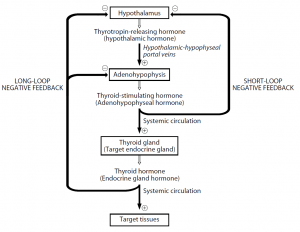Hormones of the neurohypophysis
- Antidiuretic hormone ( ADH), also known as vasopressin, has two major effects, both of which are reflected by its names:
- antidiuresis (decreased kidney formation of urine); and
- arteriol vasoconstriction.
- The antidiuretic hormone promotes water reabsorption from the kidney tubules, or antidiuresis. It acts specifically on the collecting ducts and increases the number of water channels, which increases the coefficient of water diffusion.
- This results in the conservation of water by the body and the production of a low concentrated urine volume. Reabsorbed water influences the osmolarity of plasma and the volume of blood. At relatively low concentrations, this effect of ADH on the kidney takes place.
- ADH causes constriction of arterioles at higher concentrations, which serves to raise blood pressure. The secretion of antidiuretic hormones is regulated by several factors:
- Plasma osmolarity
- Blood volume
- Blood pressure
- Alcohol
- A change in plasma osmolarity is the primary factor that influences ADH secretion. Osmoreceptors in the hypothalamus are situated in close proximity to the neurosecretory cells producing ADH.
- Stimulation of these osmoreceptors by an increase in plasma osmolarity results in neurosecretory cell stimulation; an increase in the frequency of the potential for action in these cells; and the release of ADH in the neurohypophysis from their axon terminals.
- Because of the effect of ADH on the kidney, the water retained helps to reduce plasma osmolarity or dilute the plasma back to normal.
- Hypothalamic osmoreceptors have a 280 mOsM threshold. They aren’t stimulated below this value and little or no ADH is secreted.
- When plasma osmolarity is approximately 295 mOsM, maximum ADH levels occur. The regulatory system is very sensitive within this range, with measurable increases in ADH secretion occurring in response to a 1% change in the osmolarity of plasma.

- An important mechanism by which a normal plasma osmolarity of 290 mOsM is maintained is the regulation of ADH secretion. Blood volume and blood pressure are other factors regulating ADH secretion.
- A 10% or more decrease in blood volume causes an increase in ADH secretion sufficient to cause both vasoconstriction and antidiuresis.
- A 5% or more decrease in mean arterial blood pressure also causes an increase in the secretion of ADH.
- The resulting conservation of water and vasoconstriction helps to return to normal blood volume and blood pressure.
- In addition , the effect of blood pressure on the secretion of ADH may be correlated to the increase in secretion that occurs when blood pressure decreases during sleep.
- As a result, a low volume of highly concentrated urine is produced that is less likely to elicit the reflex of micturition (urination) and interrupt sleep.
- Alcohol, on the other hand, inhibits ADH secretion, allowing for the loss of water from the kidney.
- Therefore, instead of volume expansion, the intake of alcoholic beverages may actually lead to excessive water loss and dehydration. Oxytocin has its main effects on two different target tissues as well. This hormone stimulates:
- Contraction of uterine smooth muscle
- Contraction of myoepithelial cells
- The contraction of the smooth muscle in the uterine wall stimulates oxytocin. During labour, this facilitates the delivery of the foetus and may facilitate the transport of the sperm through the female reproductive tract during intercourse.
- Oxytocin also causes the myoepithelial cells surrounding the mammary glands’ alveoli to contract. This results in “milk let down” or the expulsion of milk from deep inside the gland into the larger ducts from which the suckling infant can obtain milk more readily.
- Oxytocin secretion is regulated by reflexes elicited by suckling and by cervical stretching. Normally, the foetus is positioned head down as labour starts.
- This orientation exerts pressure and causes it to stretch on the cervix. In order to transmit signals to the hypothalamus, the sensory neurons in the cervix are thus activated, which stimulates the release of oxytocin from the neurohypophysis.
- This hormone then improves uterine contraction, causing additional pressure and extension of the cervix, additional release of oxytocin, and so on, until pressure has adequately built up so that delivery can take place.
- Suckling activates sensory neurons in the nipple in the lactating breast to transmit signals to the hypothalamus to stimulate the release of oxytocin from the neurohypophysis and, therefore, the letdown of milk.
- Interestingly, this reflex can also be triggered by a conditioned response in which the hungry infant’s sight or sound is sufficient to improve the secretion of oxytocin. Conversely, pain, fear, or stress may inhibit the release of oxytocin from the neurohypophysis. Oxytocin ‘s function in males is not clearly understood.
REFERENCES:
https://www.ncbi.nlm.nih.gov/books/NBK279157/#:~:text=The%20neurohypophysis%20is%20the%20structural,peptide%20hormones%3A%20vasopressin%20and%20oxytocin.
https://pubmed.ncbi.nlm.nih.gov/3029255/
Test Series:
